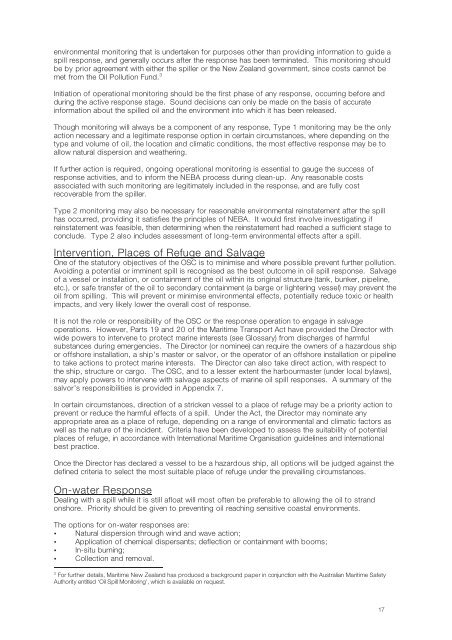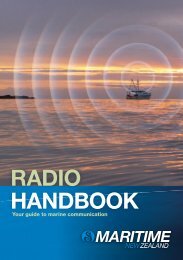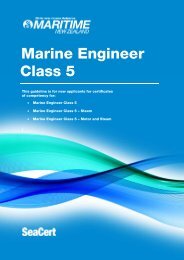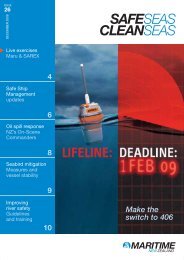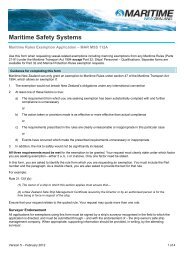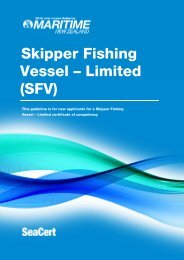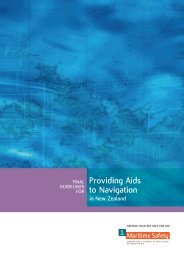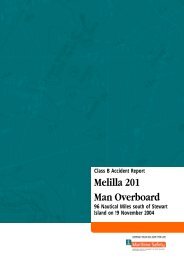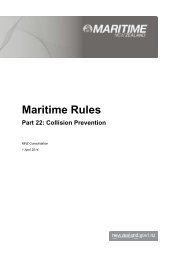New Zealand oil spill response strategy - Maritime New Zealand
New Zealand oil spill response strategy - Maritime New Zealand
New Zealand oil spill response strategy - Maritime New Zealand
Create successful ePaper yourself
Turn your PDF publications into a flip-book with our unique Google optimized e-Paper software.
environmental monitoring that is undertaken for purposes other than providing information to guide a<br />
<strong>spill</strong> <strong>response</strong>, and generally occurs after the <strong>response</strong> has been terminated. This monitoring should<br />
be by prior agreement with either the <strong>spill</strong>er or the <strong>New</strong> <strong>Zealand</strong> government, since costs cannot be<br />
met from the Oil Pollution Fund. 3<br />
Initiation of operational monitoring should be the first phase of any <strong>response</strong>, occurring before and<br />
during the active <strong>response</strong> stage. Sound decisions can only be made on the basis of accurate<br />
information about the <strong>spill</strong>ed <strong>oil</strong> and the environment into which it has been released.<br />
Though monitoring will always be a component of any <strong>response</strong>, Type 1 monitoring may be the only<br />
action necessary and a legitimate <strong>response</strong> option in certain circumstances, where depending on the<br />
type and volume of <strong>oil</strong>, the location and climatic conditions, the most effective <strong>response</strong> may be to<br />
allow natural dispersion and weathering.<br />
If further action is required, ongoing operational monitoring is essential to gauge the success of<br />
<strong>response</strong> activities, and to inform the NEBA process during clean-up. Any reasonable costs<br />
associated with such monitoring are legitimately included in the <strong>response</strong>, and are fully cost<br />
recoverable from the <strong>spill</strong>er.<br />
Type 2 monitoring may also be necessary for reasonable environmental reinstatement after the <strong>spill</strong><br />
has occurred, providing it satisfies the principles of NEBA. It would first involve investigating if<br />
reinstatement was feasible, then determining when the reinstatement had reached a sufficient stage to<br />
conclude. Type 2 also includes assessment of long-term environmental effects after a <strong>spill</strong>.<br />
Intervention, Places of Refuge and Salvage<br />
One of the statutory objectives of the OSC is to minimise and where possible prevent further pollution.<br />
Avoiding a potential or imminent <strong>spill</strong> is recognised as the best outcome in <strong>oil</strong> <strong>spill</strong> <strong>response</strong>. Salvage<br />
of a vessel or installation, or containment of the <strong>oil</strong> within its original structure (tank, bunker, pipeline,<br />
etc.), or safe transfer of the <strong>oil</strong> to secondary containment (a barge or lightering vessel) may prevent the<br />
<strong>oil</strong> from <strong>spill</strong>ing. This will prevent or minimise environmental effects, potentially reduce toxic or health<br />
impacts, and very likely lower the overall cost of <strong>response</strong>.<br />
It is not the role or responsibility of the OSC or the <strong>response</strong> operation to engage in salvage<br />
operations. However, Parts 19 and 20 of the <strong>Maritime</strong> Transport Act have provided the Director with<br />
wide powers to intervene to protect marine interests (see Glossary) from discharges of harmful<br />
substances during emergencies. The Director (or nominee) can require the owners of a hazardous ship<br />
or offshore installation, a ship's master or salvor, or the operator of an offshore installation or pipeline<br />
to take actions to protect marine interests. The Director can also take direct action, with respect to<br />
the ship, structure or cargo. The OSC, and to a lesser extent the harbourmaster (under local bylaws),<br />
may apply powers to intervene with salvage aspects of marine <strong>oil</strong> <strong>spill</strong> <strong>response</strong>s. A summary of the<br />
salvor’s responsibilities is provided in Appendix 7.<br />
In certain circumstances, direction of a stricken vessel to a place of refuge may be a priority action to<br />
prevent or reduce the harmful effects of a <strong>spill</strong>. Under the Act, the Director may nominate any<br />
appropriate area as a place of refuge, depending on a range of environmental and climatic factors as<br />
well as the nature of the incident. Criteria have been developed to assess the suitability of potential<br />
places of refuge, in accordance with International <strong>Maritime</strong> Organisation guidelines and international<br />
best practice.<br />
Once the Director has declared a vessel to be a hazardous ship, all options will be judged against the<br />
defined criteria to select the most suitable place of refuge under the prevailing circumstances.<br />
On-water Response<br />
Dealing with a <strong>spill</strong> while it is still afloat will most often be preferable to allowing the <strong>oil</strong> to strand<br />
onshore. Priority should be given to preventing <strong>oil</strong> reaching sensitive coastal environments.<br />
The options for on-water <strong>response</strong>s are:<br />
• Natural dispersion through wind and wave action;<br />
• Application of chemical dispersants; deflection or containment with booms;<br />
• In-situ burning;<br />
• Collection and removal.<br />
3<br />
For further details, <strong>Maritime</strong> <strong>New</strong> <strong>Zealand</strong> has produced a background paper in conjunction with the Australian <strong>Maritime</strong> Safety<br />
Authority entitled ‘Oil Spill Monitoring’, which is available on request.<br />
17


